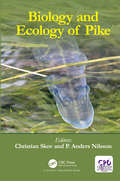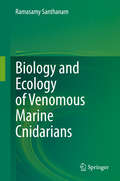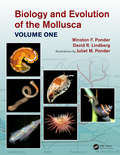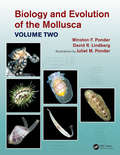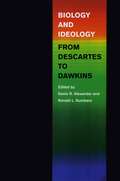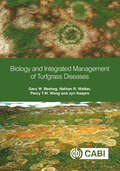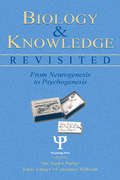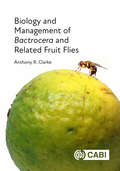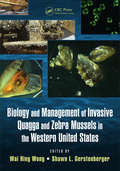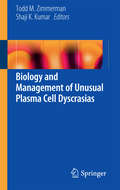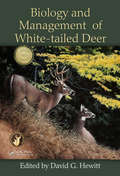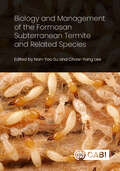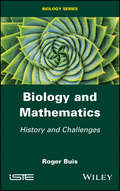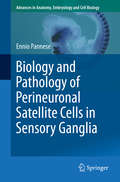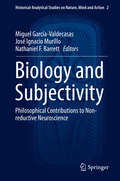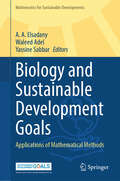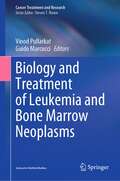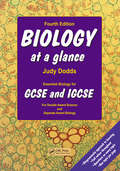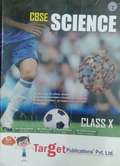- Table View
- List View
Biology and Ecology of Pike
by Christian Skov P. Anders NilssonThis book sets out to bridge the order scales among pike researchers, populations, communities, management, and fisheries. It emphasizes the progress of pike research during the last two decades, during which the order-bridging approach emerged. This framework underpins the text and the message, to convey its importance to pike research and to fish research in general. In addition, a considerable part of the book is devoted to management implications and highlights aspects of human dimensions in recreational fisheries.
Biology and Ecology of Venomous Marine Cnidarians
by Ramasamy SanthanamSeas and oceans cover 71 % of the earth’s surface and they are home to 80% of all life found on the planet . Among the different components of marine life, the phylum Cnidaria (formerly Coelenterata) has been reported to be responsible for more envenomations than any other marine phylum. It is believed that 2% of its known 11000 species are venomous to humans. Incidents caused by jellyfish are common all around the globe, with serious manifestations and occasional deaths reported in some countries. The Australian box jellyfish, Chironex fleckeri , has been reported to be very dangerous to humans, as contact with its tentacles can provoke immediate cardiovascular collapse and death within minutes. Though other volumes on venomous marine fauna are available, this is the first comprehensive book focusing on venomous marine cnidarians. It is a valuable text-cum-reference resource for researchers, teachers and students of various disciplines, including fisheries science, marine biotechnology and marine biology and for university and college libraries. It is also a useful guide for beachgoers, divers, physicians and environmentalists.
Biology and Evolution of the Mollusca, Volume 1
by Winston Frank Ponder David R. Lindberg Juliet Mary PonderMolluscs comprise the second largest phylum of animals (after arthropods), occurring in virtually all habitats. Some are commercially important, a few are pests and some carry diseases, while many non-marine molluscs are threatened by human impacts which have resulted in more extinctions than all tetrapod vertebrates combined. This book and its companion volume provide the first comprehensive account of the Mollusca in decades. Illustrated with hundreds of colour figures, it reviews molluscan biology, genomics, anatomy, physiology, fossil history, phylogeny and classification. This volume includes general chapters drawn from extensive and diverse literature on the anatomy and physiology of their structure, movement, reproduction, feeding, digestion, excretion, respiration, nervous system and sense organs. Other chapters review the natural history (including ecology) of molluscs, their interactions with humans, and assess research on the group. Key features of both volumes: up to date treatment with an extensive bibliography; thoroughly examines the current understanding of molluscan anatomy, physiology and development; reviews fossil history and phylogenetics; overviews ecology and economic values; and summarises research activity and suggests future directions for investigation. Winston F Ponder was a Principal Research Scientist at The Australian Museum in Sydney where he is currently a Research Fellow. He has published extensively over the last 55 years on the systematics, evolution, biology and conservation of marine and freshwater molluscs, as well as supervised post graduate students and run university courses. David R. Lindberg is former Chair of the Department of Integrative Biology, Director of the Museum of Paleontology, and Chair of the Berkeley Natural History Museums, all at the University of California. He has conducted research on the evolutionary history of marine organisms and their habitats on the rocky shores of the Pacific Rim for more than 40 years. The numerous elegant and interpretive illustrations were produced by Juliet Ponder.
Biology and Evolution of the Mollusca, Volume 2
by Winston Frank Ponder David R. Lindberg Juliet Mary PonderThis volume provides individual treatments of the major molluscan taxa. Each chapter provides an overview of the evolution, phylogeny and classification of a group of molluscs, as well as more specific and detailed coverage of their biology (reproduction, feeding and digestion, excretion, respiration etc.), their long fossil record and aspects of their natural history. The book is illustrated with hundreds of colour figures. In both volumes, concepts are summarised in colour-coded illustrations. Key selling features: Comprehensively reviews molluscan biology and evolutionary history Includes a description the anatomy and physiology of anatomical systems Up to date treatment with a comprehensive bibliography Reviews the phylogenetic history of the major molluscan lineages
Biology and Ideology from Descartes to Dawkins
by Ronald L. Numbers Denis R. AlexanderUntil well into the twentieth century neither scientists themselves nor the scholars who studied science linked science with ideology, a term coined in the late eighteenth century and typically employed pejoratively to designate ideas in the use of particular interests. Among the first to connect ideology and science were Karl Marx and his followers, who identified "ideologies" as ideas that served the social interests of the bourgeoisie.
Biology and Integrated Management of Turfgrass Diseases
by Dr Gary W. Beehag Dr Nathan R. Walker Dr Percy T.W. Wong Dr Jyri KaaproCultivated turfgrass is an assemblage of mown, perennial grasses or prostrate-growing forb plants and a suite of microbes all competing with each other in a common environment. This book approaches turfgrass diseases from an ecological perspective and explains with examples how wild plants and microbes have co-evolved. It addresses the identification, biology and integrated management of both common turfgrass diseases and newly emergent diseases. It includes the common and lesser-known turfgrass species, their surrounding environment and the range of beneficial and pathogenic microbes which in combination explain why disease occurs. For disease identification purposes, fungal diseases are arranged according to their predominantly cool season and warm season occurrence. Turfgrass bacterial and viral diseases, and plant parasitic nematodes are also covered. Written by a team of international authors, it combines technical expertise and practical experience. Essential for anyone involved in managing turfgrass, this book provides the know-how to identify the early warning signs of diseases, in order to manipulate the environment and minimise the damage.
Biology and Knowledge Revisited: From Neurogenesis to Psychogenesis (Jean Piaget Symposia Series)
by Sue Taylor Parker Constance Milbrath Jonas LangerBased on the Annual Symposium of the Jean Piaget Society, Biology and Knowledge Revisited focuses on the classic issue of the relationship between nature and nurture in cognitive and linguistic development, and their neurological substrates. Contributors trace the history of ideas concerning the relationship between evolution and development, and bring powerful new conceptual systems and research data to bear on understanding the problem of experience-contingent brain development and evolution. They focus on processes of phenotype construction - which fill the gap between genes and behavior - and demonstrate that evolutionary psychological models of innate mental modules are incompatible with what is known about these processes. This book presents exciting new approaches to the development and evolution of cognitive and linguistic abilities. Returning to the broad evolutionary theme of a previous meeting, the symposium focused on specifically constructivist approaches to neurogenesis and language acquisition, and their evolution. It was organized around ideas about the relationship between development and evolution raised in Piaget's books. Research in this arena has yielded cutting-edge insight into behavioral influences on brain plasticity. Two of its subthemes run throughout - a critique of modularity models popular among evolutionary psychologies and the prescient yet flawed nature of Piaget's critique of the modern synthesis of evolution. As a result, Biology and Knowledge Revisited is intended for developmental psychologists, psycholinguists, biological anthropologists, evolutionary psychologists, and philosophers of science.
Biology and Management of Bactrocera and Related Fruit Flies
by Professor Anthony R. ClarkeThroughout Asia, Australia and the Pacific, and increasingly in Africa, the primary horticultural insect pests are fruit flies belonging to the genera Bactrocera, Zeugodacus and Dacus (Diptera: Tephritidae: Dacini). The Dacini is a hugely diverse clade of nearly 900 species endemic to the rainforests of Asia, Australia and the western Pacific, and the savannas and woodlands of Africa. All these species lay their eggs into fleshy fruits and vegetables, where the maggots feed, therefore destroying the fruit. In addition to being crop pests, dacines are also invasive pests of major quarantine importance and their presence in production areas can significantly impact market access opportunities. This broad text provides a rapid introduction to this economically and ecologically important group, which includes species such as the Oriental fruit fly (B. dorsalis), Melon fly (Z. cucurbitae), Queensland fruit fly (B. tryoni) and the Olive fly (B. oleae). Broken into three primary sections, it first explores the evolutionary history, systematic relationships, taxonomy and species-level diagnosis of the Dacini flies. The following biology section covers their life history, population demography, behaviour and ecology, and natural enemies. The final section of the book covers the management of these flies, with chapters on pre-harvest, post-harvest and regulatory controls. Each chapter concludes with a list of key monographs, papers or book chapters for further reading. This book will be of interest to field entomologists, extension officers, quarantine officers and market access negotiators, as well as students of applied entomology and pest management.
Biology and Management of Invasive Quagga and Zebra Mussels in the Western United States
by Wai Hing Wong Shawn L. GerstenbergerBiology and Management of Invasive Quagga and Zebra Mussels in the Western United States is a synthesis of the biology and management of invasive mussels from scientists and managers working on invasive quagga and zebra mussels in the western United States. Invasive dreissenid mussels have spread throughout southwestern United States at unprecedent
Biology and Management of Unusual Plasma Cell Dyscrasias
by Todd M. Zimmerman Shaji K. KumarThis unique book focuses on the non-myeloma plasma cell dyscrasias. A key resource for this group of diseases, the book features the latest in emerging knowledge and therapeutic developments, including novel therapies. Each disease-specific chapter discusses biology, disease course, and appropriate therapeutic interventions, covering plasma cell leukemia, plasmacytoma, POEMS Syndrome and Castleman's Disease, Waldenström macroglobulinemia, immunoglobin deposition disease, and cryoglobulinemic syndromes, among others. The only book dedicated to this intriguing family of diseases, Biology and Management of Unusual Plasma Cell Dyscrasias will be a long-lasting reference for clinicians and scientists alike.
Biology and Management of White-tailed Deer
by David G. HewittWinner of the Wildlife Society Outstanding Edited Book Award for 2013!Winner of the Texas Chapter of The Wildlife Society Outstanding Book Award for 2011!Winner of a CHOICE Outstanding Academic Title Award for 2011!Biology and Management of White-tailed Deer organizes and presents information on the most studied large mammal species in the world. The book covers the evolutionary history of the species, its anatomy, physiology, and nutrition, population dynamics, and ecology across its vast range (from central Canada through northern South America). The book then discusses the history of management of white-tailed deer, beginning with early Native Americans and progressing through management by Europeans and examining population lows in the early 1900s, restocking efforts through the mid 1900s, and recent, overabundant populations that are becoming difficult to manage in many areas. Features: Co-published with the Quality Deer Management Association Compiles valuable information for white-tailed deer enthusiasts, managers, and biologists Written by an authoritative author team from diverse backgrounds Integrates white-tailed deer biology and management into a single volume Provides a thorough treatment of white-tailed deer antler biology Includes downloadable resources with color images The backbone of many state wildlife management agencies' policies and a featured hunting species through much of their range, white-tailed deer are an important species ecologically, socially, and scientifically in most areas of North America. Highly adaptable and now living in close proximity to humans in many areas, white-tailed deer are both the face of nature and the source of conflict with motorists, home-owners, and agricultural producers. Capturing the diverse aspects of white-tailed deer research, Biology and Management of White-tailed Deer is a reflection of the resources invested in the study of the species’ effects on ecosystems, predator-prey dynamics, population regulation, foraging behavior, and browser physiology.
Biology and Management of the Formosan Subterranean Termite and Related Species
by Nathan Lo Qian Sun Thomas Chouvenc J. Kenneth Grace Claudia Husseneder Shuji Itakura Hou-Feng Li Kok-Boon Neoh Wakako Ohmura Faith M. Oi Rudolf H. Scheffrahn Gaku Tokuda Edward L. Vargo Chia-Chien Wu Koichi YamamotoThe Formosan subterranean termite, Coptotermes formosanus, is the most destructive and invasive termite species globally. It is also the only termite species listed in the world's 100 worst invasive alien species of the Global Invasive Species Database. Annually, its infestation costs more than $4 billion in control and damage repairs in the USA alone. This book is the first comprehensive resource drawing on all the literature on C. formosanus since Tokuichi Shiraki first described the species in 1909. The book covers the worldwide distribution of this species, its biogeography, and how it has dispersed from its native range in southern China and Taiwan to different parts of the world. It describes its present taxonomic status and discusses the species' biology, ecology, foraging behavior, physiology, chemical ecology and its association with symbionts. From a practical standpoint, the authors address all of the various management options for this species, such as baits, soil termiticides, wood preservatives, inspection and detection technologies, and Integrated Pest Management (IPM) approaches. Lastly, there are chapters dedicated to another important destructive species, Coptotermes gestroi (the Asian subterranean termite), and the recently discovered C. formosanus/C. gestroi hybrids. This important book is an essential and valuable reference for researchers, graduate students, pest management professionals, chemical manufacturer personnel, building and property managers, and others. It provides readers with a comprehensive understanding of the biology and management of the Formosan subterranean termite and the Asian subterranean termite.
Biology and Management of the World Tarpon and Bonefish Fisheries
by Jerald S. AultThe core of a multibillion dollar sport fishing industry, tarpon and bonefish, two of the earth's oldest creatures, are experiencing obvious and precipitous population decline. Experienced anglers in the Florida Keys suggest a drop of approximately 90-95 percent for the bonefish population over the last 65 years. Despite the economic value of the i
Biology and Mathematics: History and Challenges
by Roger BuisTo formalize the dynamics of living things is to search for invariants in a system that contains an irreducible aspect of “fuzziness”, because biological processes are characterized by their large statistical variability, and strong dependence on temporal and environmental factors. What is essential is the identification of what remains stable in a “living being” that is highly fluctuating. The use of mathematics is not limited to the use of calculating tools to simulate and predict results. It also allows us to adopt a way of thinking that is founded on concepts and hypotheses, leading to their discussion and validation. Instruments of mathematical intelligibility and coherence have gradually “fashioned” the view we now have of biological systems. Teaching and research, fundamental or applied, are now dependent on this new order known as Integrative Biology or Systems Biology.
Biology and Pathology of Perineuronal Satellite Cells in Sensory Ganglia (Advances In Anatomy, Embryology And Cell Biology Ser. #226)
by Ennio PanneseThis volume provides a comprehensive and updated review of perineuronal satellite cells in sensory ganglia. For a long time since their discovery by Valentin in the first half of the 19th century these cells received only modest attention. However, some years ago research findings suggested that satellite cells play a role in the development and maintenance of neuropathic pain. As a result, satellite cells are now considered as possible targets for neuropathic pain treatment. Thus, interest in satellite cells has burgeoned. The review is based on the author’s own work as well as on his critical evaluation and systematic arrangement of data scattered through a large number of research papers. The following aspects of perineuronal satellite cells are covered: Shape and structure; molecular characteristics; origin and development; biological and functional properties; relationships with the ganglion sensory neuron; age-related changes; roles under physiological conditions; reactions to experimental and pathological conditions; role in neuropathic pain.
Biology and Pathology of the Oocyte
by Roger Gosden Alan Trounson Roger Gosden Ursula Eichenlaub-Ritter Alan TrounsonThe human oocyte, or egg, is the rarest and most rapidly aging cell in the body, and is essential for fertility. This book is about the development and pathology of the oocyte, and includes information on new technologies to manipulate, enhance, and control fertility. Leading world experts contribute essays on the basic and applied science of the egg, its clinical manipulation, and its pivotal role in reproductive medicine and biology.
Biology and Political Science (Routledge Studies in Science, Technology and Society #No.4)
by Robert Blank Samuel M. Hines Jnr.This book demonstrates the increasing interest of some social scientists in the theories, research and findings of life sciences in building a more interdisciplinary approach to the study of politics. It discusses the development of biopolitics as an academic perspective within political science, reviews the growing literature in the field and presents a coherent view of biopolitics as a framework for structuring inquiry across the current subfields of political science.
Biology and Subjectivity: Philosophical Contributions to Non-reductive Neuroscience (Historical-Analytical Studies on Nature, Mind and Action #2)
by Miguel García-Valdecasas José Ignacio Murillo Nathaniel F. BarrettSome may consider that the language and concepts of philosophy will eventually be superseded by those of neuroscience. This book questions such a naïve assumption and through a variety of perspectives and traditions, the authors show the possible contributions of philosophy to non-reductive forms of neuroscientific research. Drawing from the full range and depth of philosophical thought, from hylomorphism to ethics, by way of dynamical systems, enactivism and value theory, amongst other topics, this edited work promotes a rich form of interdisciplinary exchange. Chapters explore the analytic, phenomenological and pragmatic traditions of philosophy, and most share a common basis in the Aristotelian tradition. Contributions address one or more aspects of subjectivity in relation to science, such as the meaning and scope of naturalism and the place of consciousness in nature, or the relation between intentionality, teleology, and causality. Readers may further explore the nature of life and its relation to mind and then the role of value in mind and nature. This book shows how philosophy might contribute to real explanatory progress in science while remaining faithful to the full complexity of the phenomena of life and mind. It will be of interest to both philosophers and neuroscientists, as well as those engaged in interdisciplinary cooperation between philosophy and science.
Biology and Sustainable Development Goals: Applications of Mathematical Methods (Mathematics for Sustainable Developments)
by A. A. Elsadany Waleed Adel Yassine SabbarThis edited book provides a comprehensive framework for the integration of mathematical methodologies into biological research, emphasizing applications that directly address topics related to SDG 3 (Good Health and Well Being) and SDG 6 (Clean Water and Sanitation). From the mathematical modeling of infectious diseases to the design of smart agricultural systems, each chapter presents key global issues where mathematical analysis is a powerful tool for driving progress. This work emphasizes the importance of mathematical models in predicting outcomes, optimizing interventions and understanding the dynamics of complex biological systems. The central theme of the book is the application of mathematical methods, ranging from deterministic models, stochastic processes, fractional calculus and machine learning algorithms to biological problems, framed in the context of sustainability. Each chapter is crafted to showcase how mathematical models not only enhance our understanding of biological phenomena but also play a pivotal role in developing solutions to global issues such as pandemics, environmental degradation and resource management.
Biology and Treatment of Leukemia and Bone Marrow Neoplasms (Cancer Treatment and Research #181)
by Vinod Pullarkat Guido MarcucciThis book provides a concise update on current understanding of the biology of acute and chronic leukemias and other bone marrow neoplasms, including myelodysplastic and myeloproliferative disorders, and explores new and emerging treatments. There is a particular focus on the molecular abnormalities that are drivers of leukemia and on their detection by modern molecular techniques. Knowledge of the ways in which genomic and metabolic abnormalities in the hematologic neoplasms affect prognosis and treatment decision making is reviewed. Detailed attention is devoted to targeted therapies, including novel drugs, and to potential targets for future drug development. In addition, readers find in-depth discussion of cellular and antibody-based immunotherapies as well as the role of hematopoietic stem cell transplantation in the treatment of leukemias and bone marrow malignancies. The book is of special interest for hematologists, oncologists, and cancer researchers; it is also of value for hematology trainees and medical students.
Biology at a Glance
by Judy DoddsThe fourth edition of a bestseller, this book presents, in a clear, concise, and visual way, the main biological content required by all the examining boards for both the GCSE Double Award Science and separate Biology Award, including IGCSE. It is also useful as an introductory guide for AS Biology. The fourth edition has been revised to include new material on industrial fermenters and their applications, plus additional material on flowering plants.
Biology class 10 - NCERT Guide Book
by Target Publication Pvt. LtdThis book is a reference book for the students of class 10. This book is made according to the NCERT and CBSE pattern and hence it can clear all the doubts. It also includes the CBSE Sample papers. This guide is recommended for the students who wants to practise more and clear all their doubts. This reference book will help students to score better in exams.
Biology class 10 - SCERT - Kerala Board: ജീവശാസ്ത്രം മലയാളം മീഡിയം ക്ലാസ് 10 എസ്.ഇ.ആര്.ടി കേരള ബോര്ഡ്
by Kerala ScertBiology Malayalam Medium Class 10 SCERT Kerala Board 1 is divided into four parts. The lessons cover sense organs, brain and nervous systems, hormones and their actions and finally the diseases and reasons. The topics are presented with detailed illustraions and images and tables.
Biology class 11 - Maharashtra Board
by Maharashtra State Bureau of Textbook Production and Curriculum ResearchCreated by Maharashtra State Bureau of Textbook Production and Curriculum Research, this textbook for class 11 aims to create awareness about the biological sciences specially Botany, Zoology and allied aspects of biological sciences. The subject biology intends to give students understanding, and appreciation of the vast diversity of living beings, their special adaptations to their environments and evolutionary relationships.The new syllabus focuses on the conceptual principles of overall life processes, its understanding, and application in day-to-day life and ability to solve different upcoming problems and issues like conservation; different diseases and remedies, the application of technology, etc.
Biology class 11 - NCERT
by National Council of Educational Research and TrainingPublished by NCERT, this Biology Textbook for Class 11 follows the guidelines prescribed by the Central Board of Secondary Education (CBSE). Outlined, keeping in mind the syllabus of class 11, it covers all of the topics in an all-encompassing way. Detailed descriptions with clear pictures explained in lucid english language help the students to understand different Biological phenomenon with ease.
